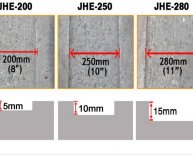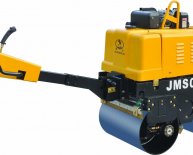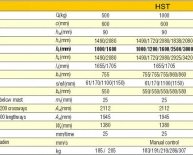
Walk behind Pallet Stacker
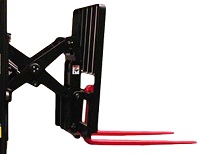 A walkie stacker or pedestrian walk-behind stacker is a walk behind pallet truck with a mast for lifting pallets to heights. There are many different types of walkie stackers that are suited to different applications. In this blog post we will outline each of them and provide some walkie stacker basic application guidelines.
A walkie stacker or pedestrian walk-behind stacker is a walk behind pallet truck with a mast for lifting pallets to heights. There are many different types of walkie stackers that are suited to different applications. In this blog post we will outline each of them and provide some walkie stacker basic application guidelines.
Walkie Stackers can be either powered or manual. They are most commonly used for transporting & lifting pallets where a forklift is not necessary; such as in store rooms, small warehouses and specialised warehousing sections or as a backup for more expensive forklifts.
These machines are perfect for small capacity items transported around a warehouse or any premises for less than 5 hours a day. They are more suited to indoor use due to their small wheels and it is recommended that they are only used on flat concrete floors, but they can be ordered from the factory with specialised requirements such as larger wheels.
Types of Walkie Stackers: Application Guidelines
There are a number of types of walkie stackers each suited to different applications. Below is a basic explanation of each of the different types.
The key distinguishing features of each type of walkie stacker is how they distribute the load: either with front legs, straddle legs or counter-balance weight.
1. Walkie Straddle Stacker
Walkie straddle stackers are the most common type of walkie stacker in Australia. They use straddle legs for distributing load weight. The legs allow them to straddle a pallet, so that the stacker can drive up closer to a pallet, without requiring as much space.
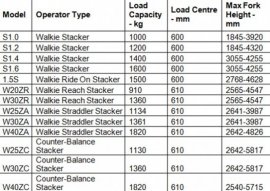 They are most commonly used for low to mid-level selective racking applications; such as store rooms, small warehouses or customer zone racking areas. The straddle legs also allow closer pallet stacking when floor stacking is employed. Racking must be configured to allow the straddled legs to move around or underneath the racking bottom beam supports. Lifting heights start at 2, 642 mm and go up to 4, 826mm.
They are most commonly used for low to mid-level selective racking applications; such as store rooms, small warehouses or customer zone racking areas. The straddle legs also allow closer pallet stacking when floor stacking is employed. Racking must be configured to allow the straddled legs to move around or underneath the racking bottom beam supports. Lifting heights start at 2, 642 mm and go up to 4, 826mm.
2. Walkie Reach Stacker
Walkie reach stackers are the next most common model in Australia.They are very similar in design to the Straddle Stacker but they are fitted with a pantographic scissor mast. This means the mast is able to move loads forward away from the body of the stacker.
They are most commonly used in applications such as loading trailers, utility vehicles and trucks. They can also be used for general mid-level racking applications similar to straddle stackers. Lifting heights start at 2, 565mm and go up to 4, 547mm.
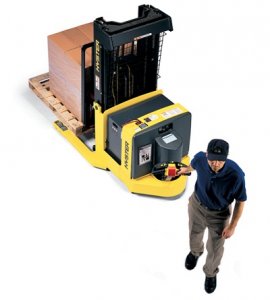 3. Ride on Walkie Stacker
3. Ride on Walkie Stacker
Ride on walkie stackers are very similar in design to standard walkie stackers but they feature a platform (or Bob) and specialised controls to allow for the operator to ride on the walkie stacker. One key disadvantage of ride on walkie stackers is that the driver requires a forklift licence to operate them, in comparison to walk behind units that don’t require any licence for operation.
Refer to 5. Standard walkie stackers for more information on this type.
4. Counter-Balance Walkie Stacker
Counter-balance walkie stackers use counter-balance weight to distribute loads; this allows them to operate in narrower aisles than the more commonly used straddle stacker because they don’t have straddling legs outside of the body of the unit.
They are also able to lift standard pallets, unlike the standard walkie stackers (with front legs). Counter-balance walkie stackers have the longest total length; due to the counter-balance weight, which results in a larger required turning circle when compared to other types of stackers.
The counter-balance walkie stacker features the highest lifting mast of the different type of walkie stackers starting at 2, 642mm and going up to 5, 817 depending on capacity.
5. Standard Walkie Stacker
Standard Walkie Stackers use legs that sit under the forks to distribute load weight. This also allows them to lift and handle two pallets at one time; making them ideal for applications that require both transportation and stacking of pallets. They also offer the smallest turning circle of the different types of walkie stackers.
One key disadvantage they have is that because the legs sit under the forks, they are only able to lift bottomless pallets or similar bottomless containers.
They are designed for med-level racking applications with lifting heights from 1, 845mm-4, 255mm.
Manual Powered Walkie Stackers
Manual powered walkie stackers are not ideal for handling pallets in racking as they have very limited lifting heights and are very slow to operate. Only recommended for general lifting with very low volume.

